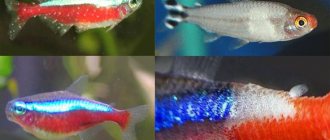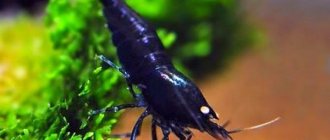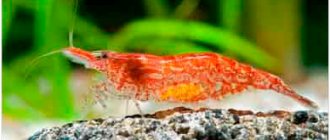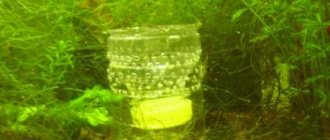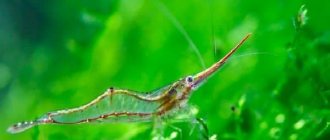Home › Aquarium shrimp › Types of aquarium shrimp ›
Your rating will be the first!
The yellow neocaridina shrimp (Neocaridina heteropoda var “yellow”) is a very rare species of completely yellow shrimp in the aquarium hobby. This shrimp species was selected by breeding from the wild Neocaridin species, as were the Red Cherry shrimp. Selection was carried out until a fully colored yellow species was obtained. Yellow shrimp are beloved by aquarists for their unique color, hardiness, and ease and speed of reproduction.
Yellow Shrimp (yellow shrimp), or rather its wild ancestors neocaridina (Neocaridina Heteropoda species), comes from Japan. This species appeared around 2006 or several years earlier. The exact date of appearance of the species is unknown, as is the name of the breeder who created it. To date, yellow shrimp are distributed throughout the world due to their high fertility.
Origin
The homeland of this type of aquarium shrimp is Japan; it was bred not so long ago, about ten years ago. And in a short time it was able to gain recognition and now it can be found in artificial reservoirs on all continents. Unfortunately, we do not have any information about the breeder who bred this lovely species. It owes its rapid spread not only to its beautiful appearance, but also to its high fertility.
Yellow beauties
NEON YELLOW SHRIMP (Neocaridina heteropoda var. “yellow neon”)
FSB
0
3 055
Share
The neon yellow shrimp is the product of the work of German and Japanese breeders with the wild variety Neocaridina heteropoda, which naturally lives in the waters of South Asia. These shrimp are very undemanding and even novice aquarists can handle them.
Neocaridina heteropoda var. “yellow neon” is painted bright yellow. There is a bright neon stripe on the back, which is how the shrimp got its name. The neon stripe is most contrasting in females; in males it is much paler. Females are larger than males and have brighter colors. The size of the male reaches 2.5 cm, and the female 3.5 cm.
It is recommended to keep neon yellow shrimp in a group of 10-15 individuals. For such a number of shrimp, an aquarium with a volume of 15 liters or more will be quite sufficient. Almost any substrate can be used as a primer, preferably dark colors. Against the background of a dark substrate, neon yellow shrimp looks most attractive. The aquarium should be densely planted with plants; it is in the midst of plants that shrimp feel completely safe. It is possible to keep shrimp in a common aquarium with peace-loving fish: tetras, rasboras, guppies. You should not keep other types of shrimp with neon yellow shrimp, as in this case they may cross with each other and, as a result, the resulting hybrids will lose their attractive color.
Water parameters: temperature 22-28° C, hardness dH 5-15°, acidity pH 6.0-8.0. The water in the aquarium should be crystal clear. Filtration, aeration and weekly replacement of ¼ of the aquarium water with fresh water are necessary.
Lighting is preferably bright. The duration of daylight is about 10 hours a day.
Neon yellow shrimp are fed a variety of specialized dry food containing spirulina, pre-sliced vegetables: carrots, zucchini, lettuce and spinach. Feed should be given once a day and exactly as much as the shrimp can eat in 1-2 hours. It is advisable to give the shrimp a fasting day once a week, which will only benefit them.
Reproduction
The neon yellow shrimp reaches its sexual maturity at 4 months of age.
There are usually no problems with shrimp reproduction. If you monitor the quality of water in the aquarium, they reproduce almost constantly. Pregnant females incubate about 30 eggs for 1-1.5 months.
The maximum lifespan of neon yellow shrimp is about 2.5 years.
Tags neon yellow shrimp, neocaridina heteropoda yellow neon
Found an error or a dead link?
Select the problematic fragment with the mouse and press CTRL+ENTER. In the window that appears, describe the problem and send it to the resource Administration.
Conditions of detention
The yellow shrimp is not too picky about the composition of the water. There is information about the successful maintenance of this breed in water with a pH of 6.0 to 8.0. and water with very different hardness. At a temperature of 22 - 28 degrees, with different soils and ordinary pebbles. Many aquarists agree that shrimp of this species, like their relatives Cherry, can live in almost any freshwater aquarium. But at the same time, of course, we must not forget that it must be properly equipped and there should be no predatory fish in it. Shrimp of this species are extremely mobile and prolific. The only obligatory condition is the purity of the water. They are really demanding about this parameter.
Yellow shrimp
Hello, dear aquarists!
yellow shrimp
Let's continue the conversation about shrimp and today we'll get to know the yellow shrimp . So!
Yellow shrimp is a freshwater shrimp, also known as “ Lemon Shrimp ”, “ Yellow Pearl ”, some aquarists call it “Canary” (because of the color that is inherent in canaries).
The size of the yellow shrimp is 2.5-3 centimeters.
Just like many representatives of modern Neocaridina, yellow shrimp is the result of selection (crossing) of several wild species.
Amazing juicy color is the hallmark of the yellow shrimp, as it is the only one of its kind in pure yellow. (When I first saw a yellow shrimp, I was very surprised. It seemed that this individual was brought from somewhere from the depths of the reactor of the Chernobyl Zone - its poisonous, somehow radioactive, yellow color was so surprising. That’s how I wanted to see it on the back of the shrimp sign "Caution: radiation!").
Like many representatives of the Neocaridina class, the “yellow pearl” is very hardy in terms of water temperature: it feels equally good at +15*C and +28*C. Acidity prefers 6.8-8.0 Ph.
With age, the color of the “yellow pearl” may change slightly: adult individuals may acquire an acid orange color.
The yellow shrimp is incredibly fertile: if the proper conditions are met (nutrition, timely water changes and aeration), it constantly walks with a sack of eggs (a real freshwater rabbit). Fertilized eggs mature within a month. When born, babies have no color - they are transparent.
You should feed the shrimp with vegetables: you can simply put pieces of zucchini, cucumber, carrots or spinach leaves on the bottom of the aquarium. In addition to vegetables, they also eat dry fish food with great pleasure. For variety, as well as to strengthen the immune system, they should be given willow, hazel and oak leaves.
As for bottom accessories, it is highly desirable to have driftwood and mosses in the aquarium (Java moss is an ideal option). With these accessories, two goals are achieved: firstly, colonies of bacteria and algae are formed on the driftwood, which the “lemon shrimp” feed on, and secondly, the moss is a natural shelter for the offspring of these aquarium inhabitants.
Breeding
Raising yellow shrimp is not difficult. Their reproduction occurs quickly and virtually around the clock. If all the shrimp in your aquarium are healthy, then their number will constantly grow, and the females will always be with eggs, which are gestated for a month and a half. There are usually about three dozen eggs under the tail of an adult female. If you look closely at such a female, you may get the impression that due to the large number of eggs they may simply fall out, but this usually does not happen. The best method for determining the hatching time of babies is the appearance of “eyes” in all eggs.
Reproduction
Yellow shrimp are very prolific, which means they reproduce quickly and almost constantly. In a healthy colony, females will be pregnant all the time. Typically, gestation lasts 30-45 days from conception to hatching, with each female bearing over 25 offspring to adulthood. Sometimes it seems that the female has so many eggs that she will now lose some. You can tell that the eggs will hatch very soon by the appearance of little eyes inside each egg. The eyes are easy to spot and you will be able to tell when the pregnancy is close to completion (see photo below).
Another way to tell that a female is close to breeding is when a new saddle appears while the female is still carrying her eggs. The appearance of the saddle indicates that new eggs have appeared, ready for fertilization, which means that the offspring from the eggs will hatch in the coming days.
Feed
The Yellow Shrimp is unpretentious in nutrition; any fish or shrimp food will suit them. You can also feed with natural products:
- blanched spinach;
- zucchini;
- seaweed feed;
- shrimp pads,
- fish flakes and so on.
Representatives of this species are fed once a day, and it is necessary to ensure that all the food is eaten within a few hours. The rest of it needs to be removed, and next time give less.
Cheerful flock
Overfeeding these shrimp is no less dangerous than feeding them stale food. Leftover or low-quality feed will not only spoil the water, but can also lead to mass mortality. Don’t forget that shrimp eat carrion only when they live in wild natural conditions. Don’t worry if you leave your charges without food for several days. Such unloading will only benefit them.
Determination of gender
Determining the sex of a yellow shrimp is very easy. Females are much larger than males, have a much darker coloration, and also have a rounded abdomen. In addition, the adult female usually has either a saddle or fertilized eggs. Also, females have a stripe along the back; males do not have it. In the photo below, look at the male, how much paler and smaller he is than the female, and pay attention to the smooth abdomen.
What are aquarium shrimp?
Aquarium freshwater shrimp vary in size and color. They are identical in structure, regardless of type.
Multi-colored aquarium inhabitants have long antennae on their heads. They perform tactile and olfactory functions. Shrimp have a wide view thanks to their eyes, which can rotate in different directions.
A shrimp's vision is its main weapon of self-defense!
The body is covered with a strong shell. It is formed from thoracic segments fused to the head. Shrimp have walking legs, with which they move along the bottom of the aquarium. The tail is long and well developed. With its help, they can perform leaping movements, fleeing from predators. The body size of each species is different, from 2 to 15 cm. Life expectancy is on average up to 1.5 years.
Externally, the shrimp is very similar to crayfish, but there is a significant difference in their structure.
Aquarium shrimp first appeared in aquariums in the 2000s, and since then they have become incredibly popular. The shrimp boom began with cherry shrimp, imported from Asia. Aquarists fell in love with it for its unusual, bright red color. Due to the great demand for shrimp, over time a separate direction of Nano-aquarium science arose. Experts have bred many new species, representatives of which have unusual, varied colors.
What to feed your pets
Spirulina tablets, special food for shrimp, and vegetables pre-scalded with boiling water are suitable as food. If there are fish in the container, the shrimp will happily feast on food that has not been eaten by the fish. Once a week, the invertebrates are given a fasting day, that is, they are not fed at all.
Photo: eggs are clearly visible in the abdomen


